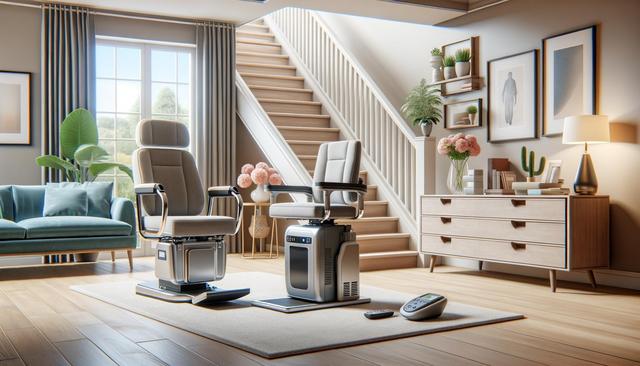Read More About Stair Lifts: A Practical Guide for Home Mobility
Stair lifts offer a safe and reliable solution for individuals with limited mobility to access different levels of their home with ease.

Understanding the Role of Stair Lifts in Home Mobility
Stair lifts have become a practical and increasingly common solution for enhancing mobility within multi-level homes. Designed to assist individuals who face challenges navigating stairs due to age, injury, or disability, these lifts can significantly improve safety and independence. The technology behind stair lifts has evolved, offering a variety of models to suit different home layouts and user needs. From the traditional seated types to the more specialized options like the Standing stair Lift, each version caters to specific mobility requirements. By reducing the need for physical exertion and minimizing the risk of falls, stair lifts allow users to move between floors comfortably and securely.
Modern stair lifts are engineered with safety features such as seat belts, swivel seats, and obstruction sensors, making them a reliable addition to the home. They can be installed on straight or curved staircases and customized to match interior aesthetics. Whether for temporary use during recovery or as a long-term mobility aid, stair lifts continue to provide a dependable solution for maintaining access to all areas of the home.
Choosing the Right Stair Lift for Your Needs
Selecting the right stair lift involves assessing both the physical needs of the user and the structural features of the home. There are several types of stair lifts available, including:
- Seated stair lifts: Ideal for users who prefer to sit while moving between floors.
- Standing stair Lifts: Suitable for those with limited knee flexibility or who find sitting uncomfortable.
- Mini Stair Lift: A compact version designed for narrow staircases or homes with limited space.
In addition to these, the Small Platform Lift and Unenclosed Vertical Platform Lift serve as alternatives for wheelchair users or those needing to transport larger mobility devices. It’s essential to consult with a mobility specialist who can evaluate your home and recommend the most practical option. Factors like weight capacity, rail type, and power supply should also be considered to ensure long-term functionality and safety.
Innovative Designs for Modern Homes
The latest models of stair lifts reflect the growing demand for both functionality and aesthetic integration within residential settings. Homeowners can now choose from a range of finishes, seat fabrics, and rail designs that blend seamlessly with existing interiors. The Innovative Staircase Lift Design for Elderly at Home exemplifies how modern engineering can provide robust support while maintaining a discreet appearance.
These innovations also include features such as:
- Remote control operation for added convenience
- Foldable footrests and seats to save space
- Quiet, smooth ride mechanisms for user comfort
These thoughtful additions make it easier for users to integrate stair lifts into their daily routines without disrupting household flow or design. As technology continues to advance, we can expect even more user-friendly and space-efficient models to become available.
Safety and Maintenance Considerations
Ensuring the safety and reliability of your stair lift involves regular maintenance and understanding the built-in safety features. Most models come equipped with battery backup systems, allowing operation during power outages. Sensors detect obstructions on the stairs, and emergency stop buttons provide immediate control if needed.
Maintenance typically includes:
- Annual professional inspections
- Regular cleaning of rails and moving parts
- Battery checks and replacements as required
Proper usage training is also crucial, especially for older adults who may be unfamiliar with powered mobility devices. When used correctly and maintained well, devices like the Stair Climber for Elderly offer long-term reliability and peace of mind for users and their families.
Accessibility Beyond the Staircase
While stair lifts provide excellent vertical mobility, broader accessibility solutions can further enhance a home’s livability. For example, the Small Platform Lift and Unenclosed Vertical Platform Lift are beneficial in homes with porches, split levels, or garage access points. These lifts can often carry both the user and their mobility aid, such as a wheelchair or walker.
Adding such equipment not only increases mobility but also promotes aging in place—a growing priority for many families. When combined with other home modifications like grab bars, non-slip flooring, and accessible bathrooms, stair lifts contribute to a comprehensive strategy for safe, independent living. Devices like the Mini Stair Lift can also be integrated in smaller spaces, making them a flexible option for compact homes or apartments.
Conclusion: Making the Right Mobility Choice
For individuals or families exploring ways to improve home accessibility, stair lifts offer a practical and effective solution. With a variety of models like the Standing stair Lift, Mini Stair Lift, and Innovative Staircase Lift Design for Elderly at Home, it’s possible to find an option that meets both physical needs and space limitations. Modern features and thoughtful designs ensure that these devices are not only useful but also comfortable and discreet.
By understanding the available options and considering both safety and convenience, homeowners can make informed decisions that enhance quality of life. Whether installing a Stair Climber for Elderly or a Small Platform Lift, each addition represents a step toward greater independence and confidence within the home.